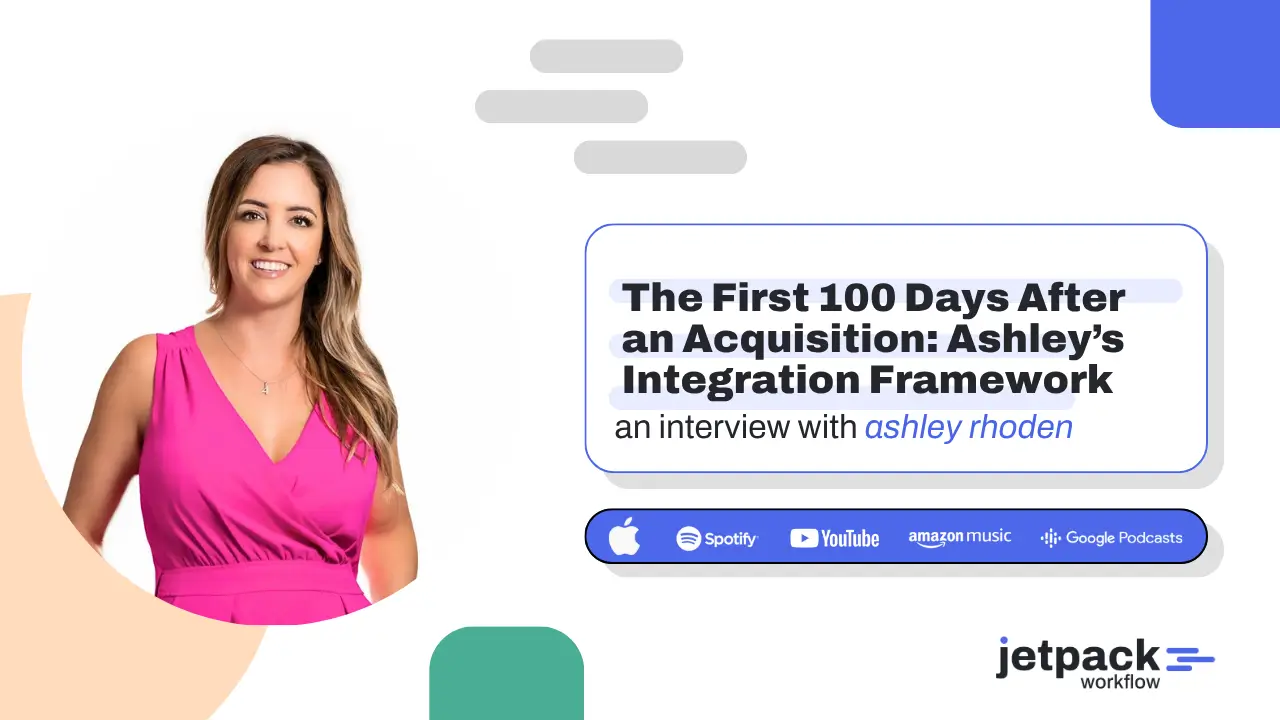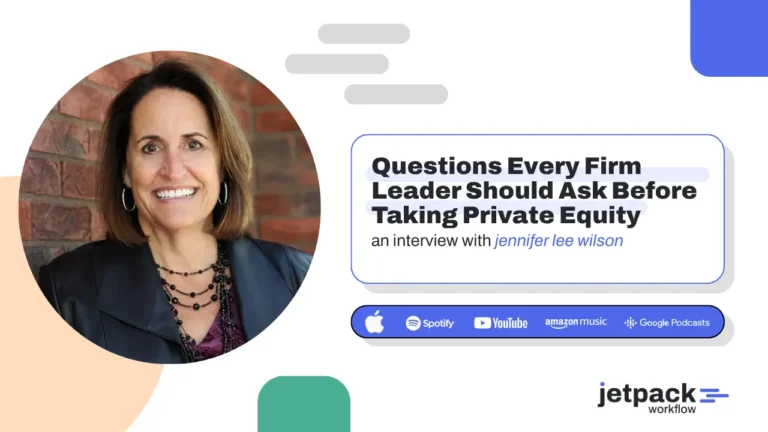The First 100 Days After an Acquisition – Ashley Rhoden’s Integration Framework

Key Takeaways
- The first 100 days after an acquisition are the make-or-break period that determines long-term success.
- Integration starts during due diligence, not after closing.
- People are the deal. Keeping talent and culture aligned preserves firm value.
- Communication should be early, frequent, and multi-channel.
- Integration success depends on systematic planning, measurable milestones, and flexibility to adjust.
Who Is Ashley Rhoden and What Does She Teach?
Ashley Rhoden has successfully led four post-M&A integrations in the accounting industry. Drawing on real-world experience, she emphasizes that what happens after closing defines whether an acquisition creates value or causes disruption.
“The first 100 days are really the make-or-break sprint that’s going to determine whether you’re going to be popping champagne in six months or putting out fires.”
Her approach focuses on planning early, executing deliberately, and prioritizing people.
Strategic Foundations
People Drive the Deal
Ashley begins by addressing a common oversight: firms often underestimate how critical people are to post-M&A success.
“People drive 100% of your client relationships and, if you lose them, you lose revenue, margins, and culture overnight.”
Uncertainty, culture clashes, or loss of autonomy can cause key employees to leave after a deal. She recommends mapping key roles during due diligence, identifying risks, and offering stay bonuses tied to six- or twelve-month milestones.
Above all, communication should be constant.
“Communicate early, often, and in multiple channels.”
Creating an Ideal Business Profile
Before reaching a Letter of Intent (LOI), firms should establish an Ideal Business Profile (IBP), a framework that goes beyond financials. It evaluates:
-
Operational capability
-
Technology stack
-
Quality standards
-
Cultural alignment and values
-
Client care philosophy
-
Compensation structures
-
Leadership transition plans
“Before you even get to the LOI, you should know where you will score high and where you will score low. It helps you determine if you’ll need more time, more money, or more help after closing.”
Cultural Alignment
Culture determines whether integration succeeds or fails. Rhoden calls it “the fuse that lights every other synergy.”
She recommends evaluating:
-
Values alignment
-
Decision-making style
-
Communication cadence
-
Partnership trust indicators
“Would you proudly put their manager in front of your top client tomorrow? If the answer is no, you might not be aligned.”
For a deeper look at how firm leaders structure deal financing, check out How to Finance Accounting Firm Acquisitions from Sarah Sharp and Shannon Hay.
Operational Execution
Due Diligence as an Integration Playbook
Ashley defines due diligence as “writing your integration playbook in real time.”
Beyond reviewing financials, she advises documenting:
-
Admin access and ownership of software systems
-
Cloud vs. legacy applications
-
Data flow between tools
-
Vendor and client payment procedures
-
Compensation analysis (including PTO and healthcare differences)
-
Role clarity and leadership mapping
“Everything you collect during due diligence rolls into your 100-day checklist that you can execute the moment the ink dries.”
Building your own 100-day integration checklist is much easier when you use workflow automation for accounting firms to keep every task, client, and milestone visible to your entire team.
Integration Team Structure
Rhoden underscores that integration is a specialized process requiring defined roles:
| Team Lead | Primary Responsibilities |
|---|---|
| HR/People Lead | Culture, benefits, morale |
| Operations | Process alignment |
| Client Lead | Retention and client communication |
| IT Systems | Data flow and security |
| Finance | Billing and vendor management |
“Assign a single integration lead with authority to unblock decisions. You don’t want roadblocks during integration.”
Day One Non-Negotiables
Rhoden stresses that the first day sets the tone for the entire process.
Firms must ensure:
-
Payroll and system access without issues
-
Documented SOPs for onboarding
-
Personal connection with top 20% of clients within 24 hours
-
Orientation packets and FAQ documents prepared before closing
“You want employees to see this as a growth opportunity, not a disruption.”
To create long-term growth after a merger, many firm owners also focus on standardizing accounting workflows that bring structure and repeatability across every service line.
Managing Change and Risks
Communication Before Closing
Many firms delay communication until closing day, creating anxiety and turnover.
Ashley contrasts the traditional surprise approach with a pre-close communication strategy, where select leaders (under NDAs) are brought in early.
“People don’t like surprises about their livelihood.”
By engaging trusted team members such as operations or HR leads before closing, firms can build internal advocates who ease the transition.
Technology and System Migrations
Rhoden notes that most acquired firms have overlapping or lagging tech stacks.
She recommends:
-
Mapping every app and data flow during due diligence
-
Consulting IT providers pre-close to identify costly gaps
-
Staging migrations: payroll and security first, core operations next, client portals last
“One small wave is better than one tidal wave. Take a phased approach.”
Change Management
Resistance is normal. Leaders must be transparent, celebrate wins, and preserve familiar rituals.
Major client changes should wait at least six months while internal systems stabilize.
“Integration success comes from systematic planning, clear communication, and the flexibility to adapt when reality doesn’t match your timeline.”
Learn how firm leaders evaluate investors before selling in Jennifer Wilson’s Guide to Private Equity Questions.
Tools and Future Planning
Protecting Client Relationships
Client trust determines ROI. Rhoden advises personal hand-off calls for high-value clients and responsive follow-ups within 24 hours.
“Your ROI rests on client stickiness. Keep employees happy, keep clients happy, and reduce churn at all costs.”
Defining the Seller’s Role
Every seller’s role should be clear, whether employee, consultant, or adviser, with measurable metrics for client retention and revenue targets.
Building a Repeatable Playbook
Integration documentation becomes a competitive advantage.
It should include:
-
Due diligence checklists
-
Timeline templates
-
Communication scripts
-
Data migration SOPs
-
RACI charts (Responsible, Accountable, Consulted, Informed)
“A playbook turns one success into many.”
Takeaways and Discussion
Ashley concludes with four essential lessons:
-
Plan integration during due diligence.
-
Put people first.
-
Communicate proactively and frequently.
-
Move deliberately, measure, and adjust.
“If you remember nothing else, invest as much time in the integration process as you do in the buying process.”
Her final message reminds firm owners that sustainable growth depends on disciplined planning and cultural care.
Conclusion
Post-M&A integration defines the long-term value of any acquisition. Ashley Rhoden’s structured, people-first approach gives firm owners a reliable framework to protect their teams, clients, and brand reputation through change.
Ready to organize your post-acquisition workflows and improve team efficiency? Start your free Jetpack Workflow trial or schedule your demo and see how automation can streamline your firm’s integration process.
Frequently Asked Questions
1. When should integration planning start in an acquisition?
Integration should begin during due diligence. Early planning lets firms assess systems, culture, and people before closing.
2. How can firms retain key staff after an acquisition?
Communicate early and often. Identify key roles, address culture fit, and offer stay bonuses tied to milestones.
3. What are the common post-M&A mistakes?
Rushing tech transitions, unclear communication, and poor alignment between buyers and sellers are frequent causes of failure.
4. How long does integration usually take?
A full integration takes about six months, starting with payroll and access, then operations, and ending with client portals.
Learn From Ashley Rhoden’s Integration Playbook
After leading four successful post-M&A integrations, Ashley Rhoden shares how structured planning, people-first communication, and systemized workflows protect firm value. See how workflow automation supports a seamless integration process.





